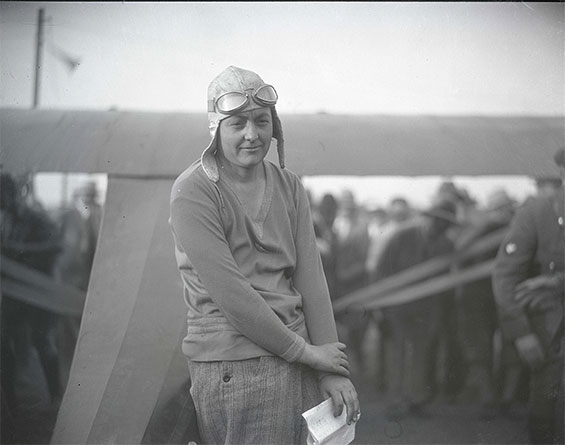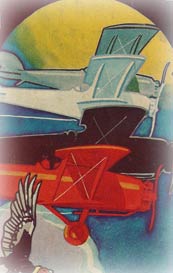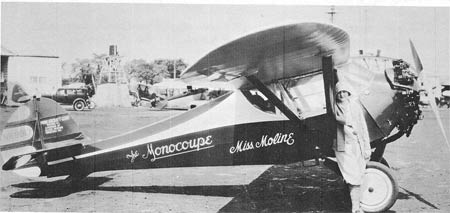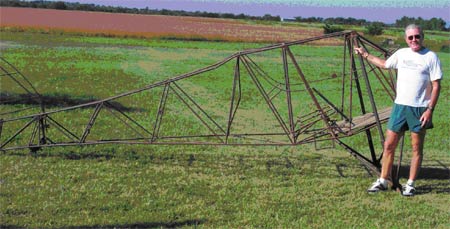|
PHOEBE, NR8917 AND THE 1929 "POWDER
PUFF" AIR DERBY
Phoebe Fairgrave Omlie (1902-1975) wove her own zodiac throughout
her flying career. Early on, in the early 1920s, she was a barnstormer, parachutist and wing walker.
She was 26 years old when she participated
in the women’s division of the 1929 National Air Races.
She was an aggressive and successful air racer, an early
female aviation mechanic (her certificate, #422, is dated
July 31, 1933), and a charter member of The Ninety-Nines.
She landed at the Davis-Monthan Field 4 times flying Monocoupes.
Besides NR8917, above, she landed with NC5877 and NC518W (twice).
She flew 518W to victory in the 1931 Derby. She was flying
another Monocoupe,
NC5878, at an airport dedication in Paragould, AR and
was involved in a crash (see below). A brief biography, current to 1934, was in Popular Aviation, March, 1934 at the link (PDF 880Kb).
Who can resist “Miss Moline”? It landed at the
Davis-Monthan Field on a hot Thursday, August 15, 1929, flown
solo by Phoebe (transport license #199). She signed the register
at 11:00AM and departed the same day at 1:30 PM for Santa
Monica to begin the 1929 Powder Puff Derby to Cleveland, OH
(image above from Juptner, v. 9, p. 127 at the 1929 Derby,
with Phoebe resting casually on the wing strut).
Her beautiful airplane is a Monocoupe Model 113 Special,
with a 110 HP Warner engine. Given “Group 2 Approval”
on September 6, 1929 (it did not have an “Approved Type
Certificate”), this fact was used by one male critic
in an attempt to cancel the women’s race. Before arrival
at the Field, NR8917 had logged about 50 hours.
Today NR8917 rests near Cheney, KS, hangared among sepia
wheat fields, a long way from its birthplace in Moline. The
fuselage had a tree growing through it when its present owners
salvaged it in 1987 from a hedgerow on the Kansas-Oklahoma
border. They rebuilt the fuselage. Then a storm in 1996 blew
their hangar down and bent longerons. “Miss Moline”
exists today outside Wichita as a fuselage and tail feathers, without wings,
awaiting restoration. They plan to rebuild
her to flyable condition “soon.”
The airplane's owner and I carried the airframe out of the
hangar to get this image of “Miss Moline” before
wheat fields in Kansas, June 7, 2002 (your Webmaster mirrors
Phoebe’s pose).
Below, she appears near the aft fuselage of what appears to be an unidentified Monocoupe. She appears weary.
Phoebe Omlie, Date & Location Unknown (Source: Link)
 |
Wings Enlargement
 |
The Oregon Historical Society source says about the photo, "Photograph of an unidentified person leaning against the fuselage of an airplane. The person is holding a piece of paper and is wearing an aviator cap and goggles. A pin in the shape of wings is attached to the person’s shirt." The wings, worn below the vee of her sweater, are enlarged, left. If you can identify the type, please let me KNOW. They don't appear to be military issue. Under magnification, the paper appears to be a tabulated listing of waypoints, perhaps noted by her during a race. Her white flying helmet is spotted with oil an grime, as are her knuckles and fingernails.
One of her events is commemorated in the following U.S. postal cachet shared by site visitor Joe Kranz. The cachet is postmarked August 23, 1930 and celebrates the National Air Races Women's Dixie Derby of the same date. According to the Aircraft Yearbook for 1931, Omlie took first place flying one of her Monocoupes and won $2,000 for her effort.
U.S. Postal Cachet, Phoebe Omlie, August 23, 1930 (Source: Kranz)
 |
AN ACCIDENT WITH ANOTHER REGISTER MONOCOUPE,
NC5878
Phoebe flew Monocoupe NC5877 to the Davis-Monthan Airfield
on July 10, 1928 during her participation in the 1928 Ford
Reliability Tour. A sister ship, NC5878
also landed at Tucson as a Tour participant (7/14/28, piloted
by L.H. Atkinson). On the weekend of October 13-14, 1928 she
took NC5878 to Paragould, AR where she assisted in the dedication
of the West-Nash Airlines
at the Paragould airport.
It is unclear what her "assistance" was, but a
contemporary newspaper article states that, "Another
possible feature on the program well be a young girl to swing
suspended from a speeding airplane by a pair of ladies' silk
stockings...." Since Phoebe was a parachutist and performed
such barnstorming tricks, she may have been the "young
girl."
On Sunday the 14th she was flying her Monocoupe with a passenger
at low altitude when, she later reported, "...the controls
jammed." The airplane spun to the ground and she suffered
two broken legs, burns on both arms, and lacerations on her
face. Her passenger suffered a broken leg and skull fracture.
She was flown to Memphis, TN by her husband and treated.
Less than a year later she was flying again in the 1929 Air
Derby (see photo top of page).
Phoebe Omlie died July 17, 1975 at age 73. Her husband, Vernon, was killed in a crash of a commercial liner in 1936. The crash was reported in three articles in the Oelwein Daily Register (IA) of August 6, 1936, below.
$50,000 AIR PLANE CRASHED KILLING 8 PERSONS.
SIX PASSENGERS AND PILOTS KILLED IN PLANE DISASTER.
TRANSPORT PLANE CRASHED FIVE MINUTES AFTER LEAVING LAMBERT-ST. LOUIS FIELD LAST NIGHT.
St. Louis, Mo., Aug. 6 -- (UP) -- A ground fog probably caused the crash of a $50,000 luxury airliner, in which eight persons were killed, A. S. Couch, aeronautical inspector for the department of commerce, said today.
The craft, City of Memphis, of the Chicago and Southern Airlines, crashed last night in a pasture 16 miles north of here. The wreckage, with seven bodies strewn about it and the eighth in the cabin, was found early today.
Couch, after a preliminary examination, said there was no apparent mechanical failure. A low-hanging fog, in the vicinity of the Missouri River, probably caused the pilot to lose his bearings, he said.
The huge plane struck with terrific force but did not burn. All occupants were killed instantly. The bodies were badly crushed.
The plane, coming from the south took off from Lambert-St. Louis airport at 10 P.M. Airport officials became alarmed when they failed to receive routine radio messages from the plane. Farmers in the vicinity were telephoned and finally a searching party was organized.
Hours later the wreckage and bodies were found. Dr. Luke B. Tiernon of Clayton, Mo., was notified.
The bodies were removed to a funeral parlor in Clayton, pending an inquest.
The crash occurred on the farm of George Behlmann, located approximately three miles from the airport and not far from the Missouri River. A path was torn in the earth for 400 feet.
Couch said his preliminary examination indicated the plane struck with both motors "wide open."
That indicated, in his opinion, that the pilot was lost in the ground fog and thought he was flying at a much greater altitude.
St. Louis, Aug. 6. -- (UP) -- Five minutes after a new, latest model transport plane left Lambert-St. Louis field last night, it crashed, killing six passengers and two pilots. Early today a searching party came upon the wreckage and made the first report of the tragedy.
Every occupant of the plane died. It crashed a few minutes after it lost radio contact with the airport, smashing down on a farm 16 miles north of St. Louis and three miles north of the field. Weather conditions while not ideal were good. Airport and airline officials could give no reason for the disaster.
A. S. Couch, aeronautical inspector for the department of commerce, told the United Press that a "ground fog" probably caused the crash. "Preliminary examination indicates," he said, "that there was no mechanical failure. A thick ground fog probably was responsible. Flying conditions were fair. The fog was low, and confined to the vicinity of the Missouri River." The bodies were taken to a funeral parlor at Clayton.
Coming in from New Orleans on schedule, the plane took off for Chicago and lost contact with the local airport. Early today word of the crash was received by telephone from farmers of the district where the accident occurred, about three miles north of the airport.
Flying conditions were excellent, company officials reported in striving to find an explanation for the crash. It was slightly cloudy, with an overcast sky, but weather conditions presented no unusual problem, it was said.
It was determined that the crash occurred not later than five minutes after it departed.
There was some official curiosity regarding delay in reporting the accident. It occurred before midnight but word of it did not reach the coroner's office of St. Louis County -- outside the district of St. Louis -- until 2:30 A.M. Airline officials said the accident was reported as soon as information reached the airport.
The dead:
W. S. BARTLETT, Chicago.
D. R. McDAVIT, Chicago.
GEORGE GRASHABER, Oak Park, Ill.
A. R. HOLT, Boston, Mass.
VERNON OMLIE, Memphis, Tenn.
CARL ZIER, Chicago, pilot.
RUSSELL MOSSMAN, New Orleans, co-pilot.
The plane was a new 10-passenger Lockheed-Electra, described as the most modern of transport ships. It left New Orelans yesterday at 5:30 P.M. It was scheduled to arrive in Chicago at 12:55 A. M. today. The department of commerce announced it would investigate the cause of the crash.
The scene of the accident was in the rolling hills adjacent to the Missouri River. It is a sparsely settled agricultural district.
The plane did not burn. Apparently it crashed nose down into a piece of pasture land. Carleton Putnam, president of the airline company, said the crash occurred shortly after 10 P.M. He said the airport lost radio contact with the plane about five minutes after it took off. "The operator called the plane repeatedly," he said, "and when it did not respond he called the Chicago airport and told them the plane was missing."
Farmers throughout that section of St. Louis county were called and finally a searching party organized, made up mostly of ground workers, mechanics and office men. They were deployed over an area of several acres and advanced on foot in the general direction the plane followed. "After searching several hours we found the wreck," Putnam said. "The plane was not badly damaged. All occupants were dead. It was impossible to ascertain the cause of the accident."
George Behlmann owned the farm where the plane crashed. He told the United Press that he was in bed when he heard the plane overhead. "The motor sounded very loud and suddenly stopped," he said. "My wife said, 'that's funny; I wounder if it crashed.'" "It seemed to me that there was some sort of noise west of my home. I got dressed and went out to look around. Other people whom I met outside said the plane crashed."
"It was very foggy and I couldn't see twenty feet ahead of me. Some people said the plane must be east of my house, so I went back to bed."
Behlmann said he got up early because he was due to take a load of corn to market. "Shortly after leaving home," he said, "I saw a group of airport men around the plane. They had just found it in a field about a quarter of a mile from my house."
An airport employee, who was with the searching party, told the United Press that he found the two pilots and five of the passengers lying within a 50 foot area around the wrecked plane. The sixth passenger was in the cabin.
The plane, apparently hit with terrific force. The bodies, the airport employee said, were badly crushed.
"I found one white shoe, fully laced, lying some distance away," he said. "That's how hard the plane hit."
St. Louis, Aug. 6. -- (UP) -- VERNON OMLIE, a passenger killed in the crash of an airliner here last night, was a noted world war flier, according to attaches of the local airport. His wife, Phoebe Omlie, was credited with being the first woman pilot in the United States. She once held the woman's parachute jumping recond.
|
---o0o---
Dossier 2.4.3
UPLOADED: 5/2/05 REVISED: 6/28/05, 03/26/08, 07/02/11, 09/13/14, 07/15/16, 07/01/18, 10/24/19
|






